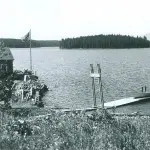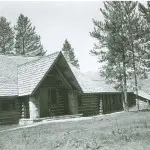The history of the AMK Ranch can be told in two parts: the homesteading era and the summer home era. It was first homesteaded by John Sargent in 1890. Sargent was one of the first settlers on the northern shores of Jackson Lake. After his suicide in 1913, the property would remain vacant and unused for a decade. It would eventually be sold at a tax auction by Teton County to William Lewis Johnson. When the Johnsons arrived on the property and built their two-story lodge (two stories because Mrs. Johnson was afraid of bears) the property was no longer a homestead, but a summer vacation home. Sargent’s large 10-room log cabin remained on the northern half of the property, while the Johnsons developed a new cluster of log buildings to the south. They built a lodge, garage-barn, woodshed, chicken house, smokehouse, power house and shop.
W. Lewis Johnson was orphaned as a young boy and send to live at the Miller Manual Labor School in Virginia. He was later expelled when he was 16, but promised to repay the school for all the opportunities it had given him. He learned the skills of iron and woodworking, and technical drawing. Because he was orphaned, his tuition was waved and he was allowed to board for free. He soon found work for Bausch and Lomb in New York, and, due to work shortages during World War I, quickly transferred to Hoover Suction Sweeper Company as a division manager. He would have a long career with Hoover, which afforded him a vacation in Jackson Hole with his wife in 1923. They stayed at Ben Sheffield’s Teton Lodge for the next several summers before looking to purchase property in the area. When they became aware of the Sargent homestead tax sale, they jumped at the opportunity to own their own lakeside property. They named it the Mae-Lou-Lodge.
In 1930 the Johnsons were in need of a caretaker to care for the property the many weeks of the year that they were not in residence. William Cecil “Slim” Lawrence and his wife Verba gladly took the position. Slim had been in Jackson as a young man and vowed to return and live there when he could afford it. Slim loved his new career as caretaker, and welcomed the many opportunities it gave him to hike, ski and enjoy the lake. He and his wife Verba regularly traveled over 15 miles in a day to retrieve supplies and mail. His tenure with the Johnsons would be short lived as Lewis Johnson died in 1931. It was Johnson’s wish to be buried on his property, which was willed to the Miller Manual Labor School. Wishing to fulfill Johnson’s will, the school sent out representative to survey the property and determined the old Sargent cabin had to come down for the gravesite. Lawrence, distraught at the proceedings, vehemently protested and told them it couldn’t be done. The School promised to replace him as caretaker if he refused. Lawrence brokenheartedly pulled the cabin down per his instructions, only to find out that the representative had misunderstood the map he was given. Lawrence saved pieces of the old cabin, but never forgave himself for the error of the Miller School.
By 1936, the property would sell to Alfred and Madeleine Berolzheimer. Alfred Berol was the President of the Eagle Pencil Company from 1946-1952, which had started in New York City in 1856. During World War II the Bavarian family, aware of the anti-German sentiment, shortened their surname to Berol. The pencil factory paused production and began manufacturing military equipment to serve the war effort. Their Jackson Hole ranch was renamed the AMK, after the three Berols: Alfred, Madeleine and their son, Kenneth.
The Berols built a new lodge north of the Johnson complex, the logs were cut from the property and laid out to dry over the winter by Slim Lawrence. The Berol lodge was accompanied by a barn, outhouse, three guest cabins and a tack cabin. The Johnson boathouse was remodeled and the dock repaired. The Berols often hosted large expensive parties in their impressive, architect-designed lodge. The ranch soon became known for the opulent parties, complete with boardwalks between the buildings to protect the guests’ clothing. This was a drastic departure from John Sargent’s early rustic homestead.
The Lawrences and the Berols got along well and eventually a separate house was constructed in 1968 for Slim and Verba. Sadly, their new house would be enjoyed together for only two short years before Verba died in 1970. Having suffered a stroke that restricted her mobility and a cancer diagnosis, she could no longer enjoy an active lifestyle. When the cancer symptoms worsened, she would become the second person to take her own life on the property. John Sargent was the first, although for very different reasons. Verba was buried in the northern peninsula of the property, separate from, but nearby the Johnsons and Sargent. Slim would later join her in 1986 from natural causes.
The Berols enjoyed 38 years of hiking, boating, riding and hunting on their secluded lakeside property. A firing range was constructed on the property, and Slim would often lead Berol to his favorite big game hunting spots around the valley. In 1974 Alfred Berol died and the property transferred to his son Kenneth. Two years later, it was sold to Grand Teton National Park and transferred to use as a research station by the University of Wyoming. Today the Park still owns the property, and it is still in use as a research station. Several public events are held there annually on talks ranging from history to science. The property also plays host to several classes, conferences and research projects with housing for up to 40 individuals.
The AMK, the Mae-Lou-Lodge and Merymere have all been part of the unique pattern of history in Jackson Hole ranging from early homesteading to modern conservation. While the early homestead is no longer visible, clues like Sargent’s grave serve as a reminder of its earlier use. The Johnson and AMK complexes have hosted visitors continuously since their construction. Today, visitors are still welcomed onto the property and the buildings are unchanged from their original appearance.
Text by Samantha Ford, Director of Historical Research and Outreach

